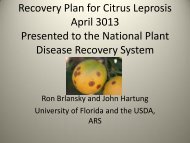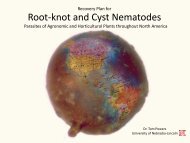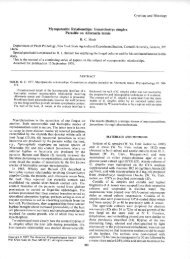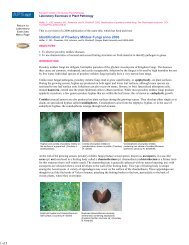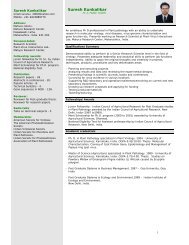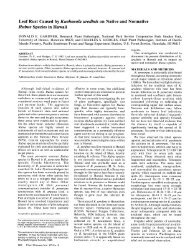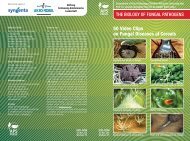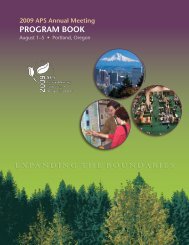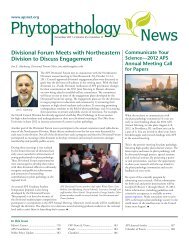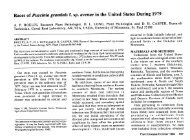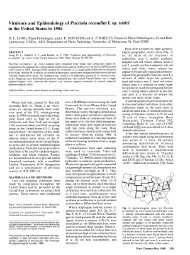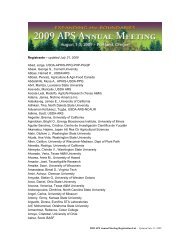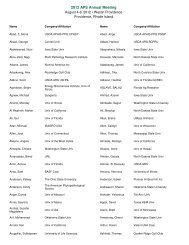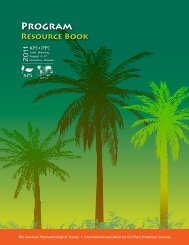view article - American Phytopathological Society
view article - American Phytopathological Society
view article - American Phytopathological Society
Create successful ePaper yourself
Turn your PDF publications into a flip-book with our unique Google optimized e-Paper software.
WISCONSIN CRANBERRY FIELD. P. G. Sanderson and S. N. Jeffers. 232<br />
Dept. of Plant Pathology, Univ. of Wisconsin, Madison 53706.<br />
VIRULENCE OF SINGLE AECIOSPORE ISOLATES OF CRONARTIUN QUERCUUN<br />
A Burkard 7-day recording volumetric spore trap was used to F. SP. FUSIFORME. E.G. Kuhlman and F.R. Natthews, USDA,<br />
determine when spores of Monilinia oxycocci, the causal agent Forest Service, SEFES, Athens, GA, 30602.<br />
of cranberry cottonball, were present in a commercial cranberry<br />
field. In 1987 and 1988, ascospores were first detected on 5 Single gall isolate LHNC-2 produced galls on twice as many<br />
May, ca. one week before bud break, and continued to be trapped seedlings of rust resistant loblolly pine family 10-5 as<br />
until one week before bloom. They occurred for 31 consecutive did standard composite isolate 1-73. Thirty-two single<br />
days in 1987 and 28 consecutive days in 1988. Conidia were aeciospore isolates from LHNC-2 were used to produce basidiospore<br />
first detected ca. 10 days before bloom in 1986, at the start inoculum for inoculating seedlings of family 10-5. Six<br />
of bloom in 1987, and at 507 bloom in 1988. Conidia were weeks after inoculation symptoms were unusually frequent.<br />
present for 34, 30, and 26 consecutive days beginning 7, 6, and Three months after inoculation with the single aeciospore<br />
17 June in 1986, 1987, and 1988, respectively. The two spore isolates, the percentage of seedlings with galls varied<br />
types never occurred concurrently. Both ascospores and conidia from 33-85. In the same experiment isolate LHNC-2 and 1-73<br />
exhibited a diurnal periodicity. Ascospores were trapped pre- produced galls on 60 and 44% of the seedlings, respectively.<br />
dominantly between 1000-2100 hr and were most abundant between Single aeciospore isolates from virulent single gall isolates<br />
1600-1800 hr. Most conidia were trapped during the daylight appear to have great potential for determining variations<br />
hours, particularly around midday. in virulence in the pathogen population and in resistance<br />
among pine families.<br />
229<br />
233<br />
THE INFLUENCE OF TEMPERATURE AND FRUIT AGE ON INFECTION<br />
OF APPLE FRUIT BY VENTURIA INAEQUALIS. K. L. Reynolds and R. C.<br />
Seem. Department of Plant Pathology, Comell University, New York State<br />
Agricultural Experiment Station, Geneva, NY 14456.<br />
COMPARATIVE VIRULENCE OF HETEROBASIDION ANNOSUM ISOLATES. F.<br />
Cobb, Jr., T. Chase, W. Otrosina, A. Ratcliff, and T. Popenuck.<br />
Dept. of Plant Pathology, Univ. of CA, Berkeley, 94720 and<br />
USDA-For. Serv. Pacific Southwest Forest Exp. Station, Berkeley<br />
Several studies have reported ontogenic resistance to V. inaequalis in apple fruit,<br />
but none has observed the effects of this resistance on germination, appressorium<br />
formation, or colonization. Attached and detached fruit were inoculated with<br />
ascospores or conidia every 3 weeks beginning at petal fall. Attached fruit were<br />
kept moist at ambient orchard temperatures for 1, 2, 4, 8 or 16 days. Detached<br />
fruit were kept moist and incubated at 13, 22, or 31 C for 94 hr. Epidermal<br />
sections were stained in cotton blue/lactophenol and examined microscopically.<br />
The proportions of spores that had germinated, developed appressoria, and<br />
successfully penetrated and formed a subcuticular stroma were recorded.<br />
Temperature had a pronounced effect at all stages of infection. Fruit age did not<br />
affect germination or appressorium formation, but the proportion of successful<br />
penetrations decreased significantly as fruit matured. These results suggest that<br />
ontogenic resistance is not due to inability of the pathogen to germinate or form<br />
appressoria, but rather to inability of the fungus to penetrate the cuticle or an<br />
interaction with the host that prevents formation of a subcuticular stroma.<br />
No differences in mortality of white fir or ponderosa pine<br />
seedlings inoculated with dikaryons and progeny homokaryons of<br />
the 'S' and 'P' groups, respectively, were apparent but results<br />
among homokaryons varied considerably. In another test, four<br />
dikaryon isolates each of 'P' and 'S' and one of H. araucariae<br />
from Australia were inoculated into seedlings of nine conifers.<br />
All 'P' isolates were highly virulent on ponderosa and sugar<br />
pines and less virulent on fir, Douglas-fir, Norway spruce,<br />
giant Sequoia and western hemlock. The 'S' isolates were most<br />
virulent on non-pine species and more variable than 'P' (one<br />
was avirulent). The Australian isolate was moderately virulent<br />
only on ponderosa pine, Sequoia, and Sitka spruce. Sitka<br />
spruce was highly susceptible to all isolates and incense-cedar<br />
was highly resistant to all isolates.<br />
230<br />
EFFECTS OF WATER STRESS ON WHITE FIR WOUND RESPONSE TO<br />
TRICHOSPORIUM SYMBIOTICUM, FUNGAL SYMBIONT OF THE FIR ENGRAVER<br />
SURVIVAL OF MUCOR PIRIFORMIS ON COLONIZED STONE FRUIT ENDOCARPS.<br />
T. J. Michailides, Univ. of Calif., Berkeley, Kearney Agric.<br />
Center, Parlier, 93648, and J. M. Ogawa, Dept. of Plant Pathology,<br />
Univ. of Calif., Davis, 95616.<br />
BEETLE. W. J. Otrosina and G. T. Ferrell, USDA Forest Service,<br />
Pacific Southwest Forest and Range Experiment Station,<br />
Berkeley, CA.<br />
Effects of water stress on white fir reaction to stem<br />
Sporangiospores of 1lucor piriformis attached to peach and<br />
nectarine endocarps an opartially buried survived better in dry<br />
(-1,300 1,300tbarn bars enari matric potend potential) partially soil buried than survve in wetd0.3bary<br />
wet (-0.3<br />
in<br />
bar<br />
mtests.<br />
matric<br />
potential) soil and longer at 0 and 10 C than at 27 and 33 C.<br />
Sporangiospores declined over time in a polynomial (quadratic)<br />
fashion in wet soil a all temperatures and in dry soil only at<br />
33 C. The fungus grew and sporulated on endocarps incubated at<br />
0, 10, and 21 C but not at 27 or 33 C. Washings from endocarps<br />
induced germination of sporangiospores of M. piriformis (up to<br />
50%) and increased its growth and sporulation. The decline of<br />
M. piriformis propagules on endocarps buried in soil in a peach<br />
orchard was exponential after the initial 5 mo. Chlamydosporelike<br />
structures developed in mycelia and sporangiophores were<br />
inoculation with the fungal symbiont of the fir engraver beetle<br />
(Scolytus ventralis LeC.) were assessed in greenhouse and field<br />
carried<br />
Inoculum<br />
by individual<br />
was selected<br />
beetles.<br />
from surveys of fungal<br />
Among<br />
populations<br />
the most prevalent fungi<br />
recovered from beetle washings were Trichosporium symbioticum,<br />
unidentified species of Cladosporium, Graphium, Paecilomyces,<br />
Penicillium, and yeasts. In both greenhouse and field<br />
inoculations with T. symbioticum, firs under high water stress<br />
(xylem pressure potentials under -2.0 mPa) produced lesions<br />
which were longer and less resinous than those of firs under<br />
lower stress. The differential host reactions to this fungus<br />
may be potentially useful in assessment of susceptibility<br />
drought stressed white fir to attack by the bark beetle-fungus of<br />
complex.<br />
found in decayed tissues. More than 75% of the colonies of M.<br />
piriformis recovered from propagules on endocarps originated<br />
from sporangiospores.23<br />
NUCLEI IN NATURE AECIOSPORES FRON TWO ZYNODENES OF PERIDERMIUM<br />
231 HARKNESSII IN CALIFORNIA. 0. R. Vogler, F. W. Cobb, Jr., and<br />
231 L. Epstein, Department of Plant Pathology, University of<br />
INTERFERTILITY OF '5' AND 'P' GROUPS OF HETEROBASIDION ANNOSUM California, Berkeley, CA 94720.<br />
IN NORTH AMERICA. T.E. Chase, W.J. Otrosina, and F.W. Cobb, Jr.<br />
USDA-Forest Service, Pacific Southwest Expt. Sta. P.O. Box 245, We used epifluorescent microscopy to count nuclei in aecio-<br />
Berkeley,CA 94701 and Department of Plant Pathology, University spores from two zymodemes (electrophoretic types) of Peniof<br />
California, Berkeley, CA 94720. dermium harknessii J. P. Noore. For each single-gall isolate,<br />
spores were fixed overnight at 4C in 3.7% formaldehyde,<br />
pelleted by centrifugation, resuspended in 0.1 ug/ml 4,6-<br />
H. annosum in North America consists of two biological species diamidino-2-phenylindole (DAPI) for 6 min, pelleted and rinsed<br />
designated '5' and 'P. In experiments to be discussed with water 6 times, and mounted in 75% glycerol in 25% phosinterfertility<br />
(% dikaryons formed) between groups in the phate buffer (pH 8). Nuclei were counted at 800X using filters<br />
western U.S. was quantified as cm. 18%. Interfertility is not recommended for DAPI by the microscope manufacturer(Zeiss).<br />
random but can be ascribed to presence of '+ intersterility Spores from zymodeme I (collected from several pine hosts<br />
alleles in both groups. Thne distribution of intersterility throughout California) were predominantly (>75%) binucleate,<br />
alleles, the nature of inter-group hybrids, their stability, while spores from zymodeme II (collected from lodgepole pine in<br />
and significance in the pathology and speciation of the fungus the central Sierra Nevada) were predominantly (>85%) uniwill<br />
be discussed. Isozymes provide additional markers for nucleate. Implications for the nuclear behavior of this<br />
monitoring heterokaryon and dikaryon formation and stability, endemic forest pathogen are discussed.<br />
1164 PHYTOPATHOLOGY<br />
234



